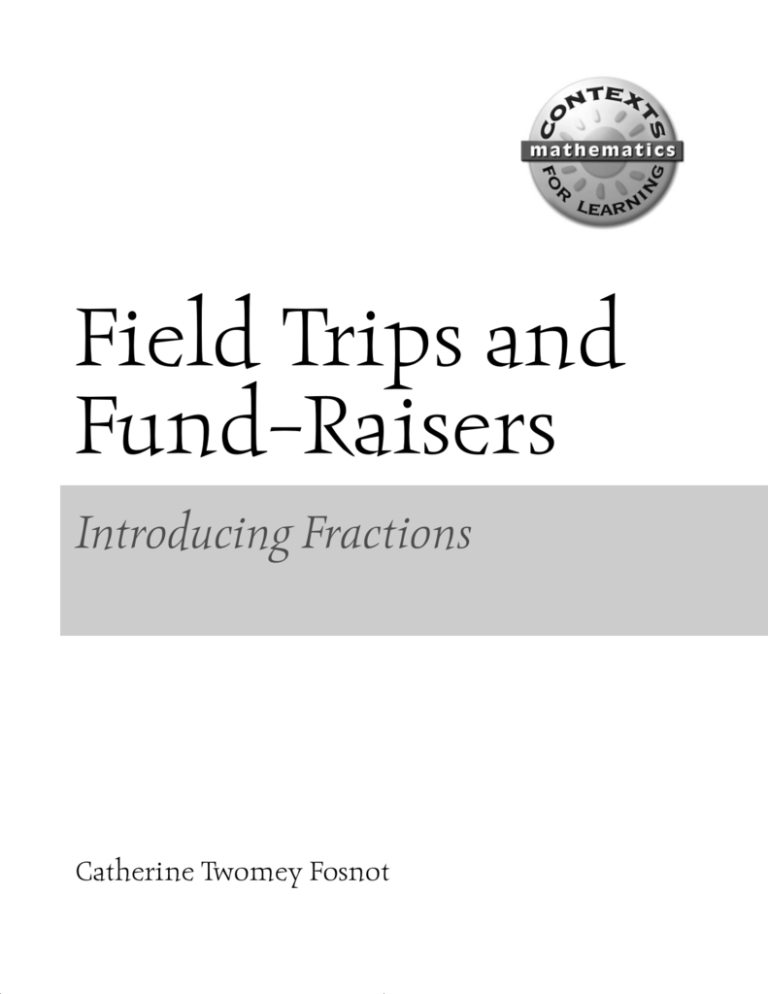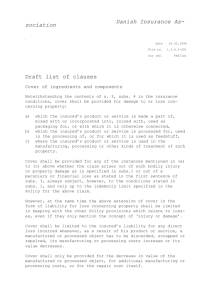
Field Trips and
Fund-Raisers
Introducing Fractions
Catherine Twomey Fosnot
firsthand
An imprint of Heinemann
A division of Reed Elsevier, Inc.
361 Hanover Street
Portsmouth, NH 03801–3912
firsthand.heinemann.com
Harcourt School Publishers
6277 Sea Harbor Drive
Orlando, FL 32887–6777
www.harcourtschool.com
ISBN 0-325-01023-4
ISBN 0-153-60575-8
Offices and agents throughout the world
© 2007 Catherine Twomey Fosnot
All rights reserved.
Except where indicated, no part of this book may be reproduced in any form or by any electronic
or mechanical means, including information storage and retrieval systems, without permission in
writing from the publisher, except by a reviewer, who may quote brief passages in a review.
Library of Congress Cataloging-in-Publication Data
CIP data is on file with the Library of Congress
Printed in the United States of America on acid-free paper
11 10 09 08 07
ML
1 2 3 4 5 6
Acknowledgements
Photography
Herbert Seignoret
Mathematics in the City, City College of New York
Contents
Unit Overview . . . . . . . . . . . . . . . . . . . . . . . . . . . . . . . . . . . . . . . . . . . . . . . . . . . . . . . . . . . . . . . . 5
Day One: THE FIELD TRIP
. . . . . . . . . . . . . . . . . . . . . . . . . . . . . . . . . . . . . . . . . . . . . . . . . . 13
The context of fair-sharing submarine sandwiches supports the
development of several big ideas related to fractions.
Day Two: THE FIELD TRIP
. . . . . . . . . . . . . . . . . . . . . . . . . . . . . . . . . . . . . . . . . . . . . . . . . . 19
A math congress gives students a chance to share and discuss their work
from Day One.
Day Three: REDISTRIBUTING
. . . . . . . . . . . . . . . . . . . . . . . . . . . . . . . . . . . . . . . . . . . . . . 23
A minilesson encourages the use of partial products and the fair-sharing
context extends to an investigation that involves redistributing.
Day Four: REDISTRIBUTING . . . . . . . . . . . . . . . . . . . . . . . . . . . . . . . . . . . . . . . . . . . . . . . . 30
A minilesson highlights a common misconception about adding fractions.
A math congress gives students a chance to share and discuss their work
from Day Three.
Day Five: WORKING WITH LANDMARKS
. . . . . . . . . . . . . . . . . . . . . . . . . . . . . . . . . . 33
The fair-sharing context extends to an investigation that involves using
landmark fractions to judge the magnitude of other fractional amounts.
Day Six: DISCUSSING STRATEGIES
. . . . . . . . . . . . . . . . . . . . . . . . . . . . . . . . . . . . . . . . 37
A math congress gives students a chance to share and discuss their work
from Day Five.
Day Seven: DEVELOPING EQUIVALENCE
. . . . . . . . . . . . . . . . . . . . . . . . . . . . . . . . . . 41
A minilesson focuses on fractions as operators and the ratio table helps
students develop strategies to make equivalent fractions.
Day Eight: THE FUND-RAISER
. . . . . . . . . . . . . . . . . . . . . . . . . . . . . . . . . . . . . . . . . . . . . . 46
A minilesson encourages simplifying when dividing. The context of
designing a bike course supports the development of a measurement
model for fractions.
Day Nine: THE FUND-RAISER . . . . . . . . . . . . . . . . . . . . . . . . . . . . . . . . . . . . . . . . . . . . . . 50
A minilesson revisits simplifying when dividing. The bike course
investigation concludes with an exploration of equivalent relationships.
Day Ten: FRACTION BAR CAPTURE . . . . . . . . . . . . . . . . . . . . . . . . . . . . . . . . . . . . . . . . 53
The Fraction Bar Capture game gives students more experience with
determining equivalent relations.
Reflections on the Unit
Appendixes A—G
. . . . . . . . . . . . . . . . . . . . . . . . . . . . . . . . . . . . . . . . . . . . . . . . . . . . 55
. . . . . . . . . . . . . . . . . . . . . . . . . . . . . . . . . . . . . . . . . . . . . . . . . . . . . . . . . . . . 56
Posters, recording sheets, and game materials
DAY ONE
The Field Trip
oday, the context of fair-sharing submarine sandwiches is introduced
to support the development of several big ideas related to fractions.
Students explore four situations: 3 subs shared by 4 people, 4 subs
shared by 5 people, 7 subs shared by 8 people, and 3 subs shared by 5 people.
Students work with partners to determine how much of a sub each person in
each of these groups receives. They then make posters of some of the ideas
they want to share in a math congress, to be held on Day Two.
T
Day One Outline
Developing the Context
3
3
Tell the story about the distribution of submarine sandwiches on a
field trip.
Ask students to work in pairs to determine if the distribution was fair
and to figure out what portion of a sandwich each person received.
Supporting the Investigation
3
3
3
Materials Needed
Field trip posters [If you
do not have the full-color
posters (available from
Heinemann), you can use
the smaller black-andwhite versions in
Appendix A.]
Large chart paper—
a few sheets per pair of
students
Connecting cubes—one
bin per pair of students
Calculators, as needed
Markers
Note students’ strategies as they investigate how much of a sub each
person received.
Ensure that they indicate where the subs should be cut.
Support students as they move on to figure out which group received
the most to eat.
Preparing for the Math Congress
3
3
Have students make posters of the ideas and strategies they want to
present during the math congress on Day Two.
Review students’ posters to determine who you will have share during
the congress and what strategies you will highlight.
Day One
13
Developing the Context
the story about the distribution of
3 Tell
submarine sandwiches on a field trip.
students to work in pairs to
3 Ask
determine if the distribution was fair
and to figure out what portion of a
sandwich each person received.
Display the four field trip posters (or Appendix A) as you tell the following
story:
A fifth-grade class traveled on a field trip in four separate cars. The
school provided a lunch of submarine sandwiches for each group. When
they stopped for lunch, the subs were cut and shared as follows:
• The first group had 4 people and shared
3 subs equally.
Behind the Numbers
The numbers in this story have been chosen
purposefully. Many students initially think that
3 subs for 4 people, 4 subs for 5 people, and 7
subs for 8 people are equivalent situations
since there is always 1 sub fewer than the
number of people. They will usually also argue
that 3 subs for 4 people is not equivalent to 3
subs for 5 people, because more people are
sharing when there are 5 and thus the pieces
are smaller. When students go off to
investigate, they will be surprised to discover
that the first three situations are not equivalent.
But they are correct about the fourth situation,
and this beginning notion of fractions as
division will be deepened as you proceed
through the unit. Given these specific numbers
in the context, students’ conceptions at the start
regarding proportional reasoning are
illuminated. Don’t try to dissuade them of their
convictions at this point. Just facilitate a
discussion and then let them work in pairs to
figure out how much each person in each
group received. Use the discussion as a
motivator for inquiry and let them be surprised
at the results.
• The second group had 5 people and shared
4 subs equally.
• The third group had 8 people and shared
7 subs equally.
• The last group had 5 people and shared
3 subs equally.
When they returned from the field trip, the
children began to argue that the distribution of
sandwiches had not been fair, that some children
got more to eat than the others. Were they right?
Or did everyone get the same amount?
Facilitate a preliminary discussion in the meeting area
before the students set off to work. Allow students to
share their initial thoughts and then ask them to work in
pairs to investigate these questions:
1. Was the distribution fair—did each person in
each group get the same amount?
2. How much of a sub did each person get,
assuming the pieces were cut equally?
Supporting the Investigation
students’strategies as they
3 Note
investigate how much of a sub each
person received.
3 Ensure that they indicate where the
Assign math partners and give each pair of students some large chart paper.
Have calculators and bins of connecting cubes available so that students may
use them if they wish. Confer with students as needed to support and
challenge.
subs should be cut.
students as they move on to
3 Support
figure out which group received the
most to eat.
14
FIELD TRIPS AND FUND-RAISERS
Conferring with Students at Work
Author’s Notes
Inside One
Classroom
Gabrielle: Three subs for 5 people. I think we should cut each sub in
half first.
Move around the room, noting the strategies
being used. Confer with a few groups as they work.
Michael: OK. (Makes a line through each of three subs at the halfway point,
producing six halves.) But there are only 5 people. What do we do with
this last half?
Many students will start by cutting the
sandwiches into large landmark pieces such as
halves or thirds. When faced with the leftover
pieces, they will then cut slivers and struggle
with what to name those pieces.
Gabrielle: Let’s cut that up into 5 pieces. There. So everyone in this car
got 1⁄2 + 1⁄5. Now let’s do 3 subs for 4.
Caroline (the teacher): (pointing to the small sliver) Tell me about
this piece.
Gabrielle: We cut it into 5 pieces so everyone could have a piece of
what was left.
Caroline: I see that you wrote 1⁄5 on your paper. Is this 1⁄5 of a sub?
Gabrielle: Oh… No. It is 1⁄5 of the half.
Caroline: Hmmm…1⁄5 of 1⁄2? I wonder how much of the whole sub
that is?
Take note of the various struggles and strategies you
see as students investigate how much of a sub each
person got. Encourage struggles to become beautiful
inquiries! As students cut up the subs, you might
see them
✦
cut each sub into landmark fractions first, such as
halves or thirds, and then cut the remainder into
slivers. This strategy may cause them to struggle
with what to name each piece: What do you call 1⁄5
of a half? [See Figure 1, page 16]
✦
cut each sub into a number of pieces that is the
same as the number of people. For example, when
sharing 3 subs among 5 people, each of the 3 subs
is cut into 5 pieces, resulting in 1⁄5 of each sub per
student, or 3 1⁄5. This strategy may cause students
to struggle with the notion that fractions are
relations and that the size or amount of the whole
matters. Everyone gets 3⁄15 of the pieces, but this
Day One
By staying grounded in the context of the
sandwich, Caroline encourages the students to
realize that the size of the whole matters: 1⁄5 of
a half is not the same as 1⁄5 of a sandwich.
By asking the students to reflect on how many
slivers ( 1⁄5 of 1⁄2 ) will fit in the whole sandwich,
Caroline supports them to realize that if the
other half were cut similarly there would be ten
slivers. She helps them to realize that 1⁄5 of 1⁄2
is 1⁄10.
Behind the Numbers
When they begin to compare and/or add pieces
together, some students may attempt to
represent subs with the connecting cubes, but
may not make equal size subs. If you see
students using various sizes, be sure to point
this out by asking if one group received bigger
subs. Stay grounded in the context to help
students realize the meaning of what they are
doing. As students struggle to ensure that the
subs are all the same size, they will need to
grapple with what numbers would be easy to
use for the size of a common-length sub in
order to compare and/or add the fractional
amounts. Ten cubes may work nicely for fifths,
but not so nicely for fourths or eighths! This
inquiry will push students toward constructing
the idea that a common multiple would be
helpful. This idea is important for the
construction of common denominators.
15
amount is also 3⁄5 of one sub. Students may also notice that
fractions can be thought of as division: 3 subs shared by 5
people results in 3⁄5, or 3 1⁄5. [See Figure 2]
✦
Figure 1
use the long division algorithm or a calculator to derive a
decimal quotient: 3 divided by 5 equals 0.6. This strategy
often prompts students to inquire about equivalence,“How
is it that some students got 3⁄5 and I got 0.6?” Encourage
students to consider whether one answer is wrong or
whether they are equivalent.
Ensure that all students indicate where the cuts would be
made. If some students use a calculator to derive, for example,
a quotient of 0.6 for 3 divided by 5, ask them to determine
where the decimal equivalent would be on their drawing of the
submarine sandwich. If they have not worked with decimals
prior to this unit and they ask you what the decimal point
means, you can tell them that 0.6 means six-tenths and then
encourage them to think of the sandwiches in tenths.
Once students have cut up or shared the subs, they have to
compare the results to determine which group got the most.
Here you might see students
✦
work with unit fractions and ignore equivalent amounts:
1. three subs for 4 people is 1⁄2 + 1⁄4
2. four subs for 5 people is 1⁄2 + 1⁄5 + 1⁄10
3. seven subs for 8 people is 1⁄2 + 1⁄4 + 1⁄8
4. three subs for 5 people is 1⁄2 + 1⁄10
Figure 2
In each case everyone got at least 1⁄2 , so those halves can be
ignored when comparing the situations. Group #3 received 1⁄8
more per person than group #1, and group #2 received
1
⁄5 more per person than group #4. Hence, groups #1
and #4 can be ruled out and only groups #2 and #3 need
to be compared to determine which of the four groups
got the most. This strategy brings students nicely to
examining denominators as divisors. One sub shared by
4 people results in larger pieces than 1 sub shared by 5
people! Similarly, 1⁄8 is a larger piece than 1⁄10. When
comparing unit fractions, the greater the denominator,
the smaller the piece is. [See Figure 3]
✦
compare common fractions or decimal equivalents
by finding a common whole.
Figure 3
16
FIELD TRIPS AND FUND-RAISERS
If students have divided each sub by the number of people
in the group, they have obtained 3⁄4 , 4⁄5 , 7⁄8 , and 3⁄5 (or decimal
equivalents) and now they have to compare those fractions. This
strategy usually produces an inquiry about what size to make the
subs so that they can be compared. At first, students may simply
use trial and error, but eventually they will recognize that it is
easier to use a common multiple of the number of people (a
common denominator). [See Figure 4]
Preparing for the Math Congress
After a sufficient amount of time has been devoted to the
investigation, ask students to make posters in preparation for the
math congress to be held on Day Two. Explain that the posters need to be
clear for others to understand. They should not be just students’ draft notes
copied over. They should be concise and clear presentations of the important
ideas and strategies students want to present.
Mathematicians write up their mathematics for math journals. In these
articles, they do not merely reiterate everything they did. Instead, they craft
a proof or argument for other mathematicians. Doing this not only
generates further reflection, it focuses the author on developing a
convincing and elegant argument—an important part of mathematics. Of
course, elementary students are not expected to write formal proofs, but by
focusing on the justification and logic of their arguments you are helping
them develop the ability to write up their ideas for presentation in a
mathematical community. For example, if students have constructed the
idea that fractions are division, that 3 subs for 5 children is 3⁄5 of a sub for
each child, push them to generalize the idea and suggest that they focus
their poster on proving this generalization.
Figure 4
students make posters of the
3 Have
ideas and strategies they want to
present during the math congress on
Day Two.
students’posters to determine
3 Review
who you will have share during the
congress and what strategies you will
highlight.
■ Tips for Structuring the Math Congress
Plan on structuring a congress to discuss some of the big ideas related to
fractions. Examine the posters as you plan for the congress and think about
how you want the conversation to flow. By noting students’ struggles and
strategies, you can make a decision regarding which students you will ask to
share and the strategies you will highlight.You will want to be sure to discuss
the idea that fractions can be thought of as division: 3 subs shared by 5
people results in 3⁄5 of a sub per person.
Usually, some student work will also illustrate a unit fraction strategy.
Highlighting such a strategy will generate discussion of big ideas such as
the following:
✦
the size or amount of the whole matters
✦
with unit fractions, the greater the denominator, the smaller the piece is
✦
when naming the piece, the whole matters (what to call 1⁄5 of 1⁄2 , etc.)
Day One
17
Reflections on the Day
Several big ideas about fractions were explored today as students
investigated the fair-sharing situation. Some groups grappled with how to
compare the amounts and developed a beginning understanding of common
denominators. Others grappled with equivalence, for example, what to call 1⁄5
of 1⁄2. Some realized that with unit fractions, the greater the denominator, the
smaller the piece is. Still others, using a division strategy, determined that 3
subs shared by 5 people results in 3⁄5 of one sub per person and they worked
to generalize this idea.
18
FIELD TRIPS AND FUND-RAISERS





